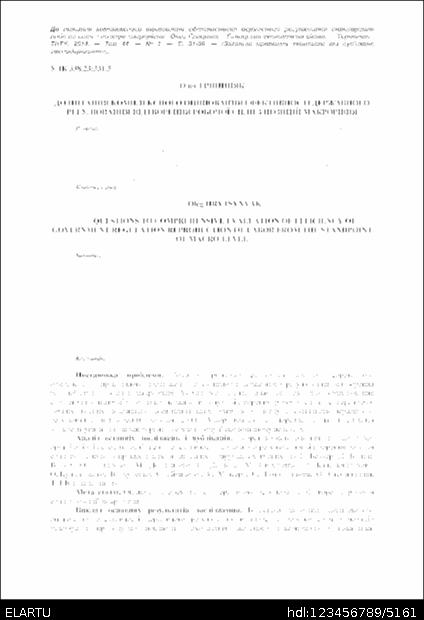Použijte tento identifikátor k citaci nebo jako odkaz na tento záznam:
http://elartu.tntu.edu.ua/handle/123456789/5161

| Název: | До питання комплексного оцінювання ефективності державного регулювання відтворення робочої сили з позицій макрорівня |
| Další názvy: | Questions to comprehensive evaluation of efficiency of government regulation reproduction of labor from the standpoint of macro-level |
| Autoři: | Hrytsynyak, Oleg |
| Bibliographic description (Ukraine): | Грициняк О. І. До питання комплексного оцінювання ефективності державного регулювання відтворення робочої сили з позицій макрорівня / Олег Грициняк // Галицький економічний вісник — Тернопіль : ТНТУ, 2014. — Том 44. — № 1. — С. 81-86. — (Загальні проблеми економіки та суб’єктів господарювання). Hrytsynyak O. Questions to comprehensive evaluation of efficiency of government regulation reproduction of labor from the standpoint of macro-level / Oleg Hrytsynyak // Galician economic bulletin — Ternopil : TNTU, 2014. — Volume 44. — No 1. — P. 81-86. |
| Datum vydání: | 20-bře-2014 |
| Date of entry: | 5-pro-2014 |
| Nakladatel: | Тернопiльський національний технiчний унiверситет iменi Iвана Пулюя |
| Place of the edition/event: | Тернопіль |
| UDC: | 338.23 331.5 |
| Klíčová slova: | ефективність державне регулювання робоча сила алгоритм оцінювання efficiency government regulation labor force estimation algorithm |
| Abstrakt: | Розглянуто питання теорії дослідження ефективності державного регулювання відтворення робочої сили з позицій макрорівня. Автор для оцінювання державного регулювання відтворення робочої сили використовує узагальнюючий інтегральний показник із застосуванням методу таксономічного показника розвитку. Даний показник відображає одночасно всі сукупні зміни в системі статистичних показників відтворення робочої сили, які розподілено на групи відповідно до фаз відтворення робочої сили: формування робочої сили, розподілу робочої сили та її реалізації. На думку автора, використання даної методики дозволяє виявити недоліки в регулюванні робочої сили на кожній фазі її відтворення. Алгоритм комплексного оцінювання ефективності державного регулювання відтворення робочої сили доречно представити у вигляді запропонованої автором схеми. Problems of the theory research of state regulation efficiency of labor force reproduction from macrolevel point is considered in this article. For the assessment of state regulation of labor force reproduction the author uses a general integral index based on the method of taxonomic index development. This index reflects simultaneously all aggregate changes in the statistical parameters of labor force reproduction, which are divided into groups according to the phases of labor force reproduction: the labor force formation, labor force division and its implementation. The author supposes that the use of this technique allows identifying deficiencies in the regulation of the labor force in each phase of its reproduction. The author presents an integrated index estimation of state regulation efficiency of labor force reproduction as a hierarchy of indicators: the first level is presented by indicators-signs; the second level is represented by the integral parameters describing the state of each group of indicators; the third level of the hierarchy is represented by a general integral indicator that comprehensively describes the effectiveness of state regulation of labor force reproduction as a whole. The economic meaning of this index demonstrates the fact that the level of efficiency of state regulation of the labor force is the best in the period where the integral index value is the closest to 1. In the article it is concluded that algorithm of complex estimation of state regulation efficiency of labor force reproduction is appropriate to be represented as the proposed by the author’s scheme. |
| URI: | http://elartu.tntu.edu.ua/handle/123456789/5161 |
| Copyright owner: | © „Галицький економічний вісник Тернопільського національного технічного університету“ |
| Content type: | Article |
| Vyskytuje se v kolekcích: | Галицький економічний вісник, 2014, № 1 (44) |
Soubory připojené k záznamu:
| Soubor | Popis | Velikost | Formát | |
|---|---|---|---|---|
| GEB_2014v44n1_Oleg_Hrytsynyak-Questions_to_comprehensive_81-86.pdf | 712,07 kB | Adobe PDF | Zobrazit/otevřít | |
| GEB_2014v44n1_Oleg_Hrytsynyak-Questions_to_comprehensive_81-86.djvu | 94 kB | DjVu | Zobrazit/otevřít | |
| GEB_2014v44n1_Oleg_Hrytsynyak-Questions_to_comprehensive_81-86__COVER.png | 6,47 kB | image/png | Zobrazit/otevřít |
Všechny záznamy v DSpace jsou chráněny autorskými právy, všechna práva vyhrazena.